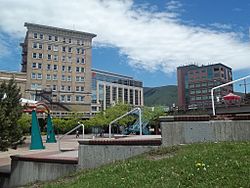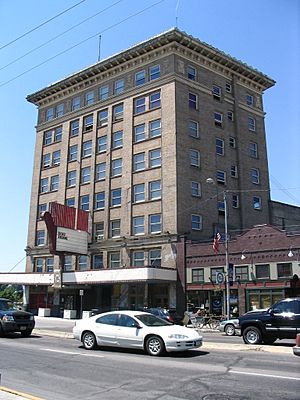Downtown Missoula facts for kids
Quick facts for kids
Downtown Missoula
|
|
|---|---|
|
Neighborhood
|
|
 |
|
| Country | United States |
| Area | |
| • Neighborhood | 2.05 sq mi (5.3 km2) |
| Elevation | 3,205 ft (975 m) |
| Population
(2009)
|
|
| • Neighborhood | 2,138 |
| • Urban | 68,876 |
| • Metro | 108,623 |
| Time zone | North American Mountain Time Zone |
| Website | missouladowntown.com |
Downtown Missoula is the main business area in Missoula, Montana. It is located in West-Central Montana. Its general borders are the Clark Fork River to the south and Madison Street to the east. To the west, it's bordered by North Orange Street, and to the north by West Alder Street. Sometimes, parts south of the Clark Fork River are also included. Downtown Missoula is home to Ogren Park at Allegiance Field, where the Missoula Osprey baseball team plays. You can also find several parks and historic buildings here, like the famous Wilma Building.
Contents
History of Downtown Missoula
How Downtown Missoula Grew
Missoula didn't have a sudden "boom" like some other towns during the gold rush. However, it grew quickly. By 1872, the town had 66 new buildings. Early businesses like Higgins and Worden set up the first stores and banks. Later, the Missoula Mercantile Company became a big competitor.
Growth slowed down in the 1880s. But when the Northern Pacific Railway arrived in 1883, Missoula started growing fast again. The need for wood for the railway led to many sawmills opening. This started Missoula's lumber industry. This busy time led to the building of many historic structures you see downtown today.
A. J. Gibson, an architect, came in the late 1880s. He designed many well-known buildings. These include the Missoula County Courthouse and the University of Montana's Main Hall. The Wilma Building was finished in 1921. It was the first steel-framed building in Missoula.
Modern Times in Downtown Missoula
Many important things happened in Downtown Missoula during the 20th century.
- Streetcars started running in 1910. They were replaced by buses in 1932.
- The current city hall was finished in 1969.
- The last passenger train left Missoula in 1979.
- A special carousel for Missoula opened in May 1995.
The modern era began when all the logging yards in Missoula closed. Logging used to be the main part of Missoula's economy. After logging ended, the Missoula Downtown Association was formed.
Some of Missoula's biggest modern buildings include the First Interstate Center (Missoula) and the First Security Bank. There's also the new St. Patrick Hospital and Health Sciences Center. The tallest building downtown is the Millennium Building. The Garlington Building (Missoula, Montana) was completed in 2010, adding to the city's skyline.
New Projects Happening Now
Sawmill District Changes
The Sawmill District is an area near downtown Missoula that used to be a mill site. It is now being rebuilt. This project will create a mix of homes and businesses. It will offer different types of housing. Once finished, it will be close to downtown. It will also have open spaces like the new Silver Park and access to the Clark Fork River.
The project will include new streets. One new street will connect Wyoming Street and Cregg Lane. This will also create a new link between Russell Street and Orange Street. Silver Park will be a new 14-acre park. It will have green spaces, shelters, playgrounds, art, a new parking lot, and a boat ramp for the Clark Fork River.
Russell Street Apartments
A local company has started building a large apartment complex. It will have 224 apartments. The first units are expected to open by July 2013. This project costs $19.5 million. It is being built on an empty space on Russell Street, close to downtown Missoula.
This "mini" community will offer homes for people with low to medium incomes. It will also include commercial buildings along Russell Street. The complex will have a clubhouse, a swimming pool, and even a movie theater for residents.
Higgins and Front Area
The area around Higgins and Front streets is seen as the very center of downtown. It started growing in the late 1800s and has continued to develop. In the early 1900s, this part of downtown had electric streetcars. The last streetcar ride in the city was in January 1932.
The brick streets here were replaced in the 1940s and 1960s. This area has been recognized for keeping its historic buildings. Many of Missoula's main downtown buildings are located here. These include the Wilma Building, the Wilma Theatre, and the Millennium Building. Other important buildings are the First Interstate Center (Missoula), the Florence Hotel, and the newer Garlington Building (Missoula, Montana).
Downtown Buildings
Aber Hall is on the campus of the University of Montana. It has 11 floors and is one of the tallest buildings in Missoula, along with its twin, Jesse Hall. The only other tall building in downtown Missoula is the Millennium Building, which has 9 floors.
Other important historic or modern buildings in Missoula include the Wilma Building, the Garlington Building, and the Florence Hotel. Missoula has over 60 buildings listed on the National Register of Historic Places.
Tallest Buildings Downtown
| Place | Address | Floors | Year(s) built | Primary use |
|---|---|---|---|---|
| Millennium Building | 125 Bank Street | 9 | 1996–98 | office/residential |
| Wilma Building (historic) | 131 S. Higgins Ave | 8 | 1921 | Theatre/residential |
| Florence Hotel | 111 N. Higgins Ave. | 7 | 1941 | Hotel/residential |
| Park Place parking structure | 201 East front st | 7 (2 below ground) | 2010–2012 | Parking structure/retail |
| First Interstate Center | 101 E. Front Street | 6 | 2008–09 | office |
| First Security Bank | 100 E. Broadway | 6 | office | |
| Garlington Building | 138 West Broadway | 6 | 2010 | Office |
Cityscape
Geography of Downtown Missoula
Downtown Missoula is mostly flat. Near the Clark Fork River, there are some small slopes. These are still easy to walk on for activities like fishing or swimming. Since downtown Missoula is in a valley, the ground can sometimes be uneven. But overall, the terrain is easy to move around.
The University of Montana district is located just upstream from the Clark Fork River. This makes downtown even busier when school is in session. Downtown Missoula also has two main parks. In the past, downtown Missoula had problems with smog, which caused air pollution.
Growing Downtown
Many new small businesses and organizations have moved into the downtown area. One important group started right in downtown: the Missoula Downtown Association (MDA). The MDA was formed in 1975. It has helped organize almost every event in the downtown area for many decades.
With the help of the MDA, Caras Park has become a main event spot. Caras Park is right next to the heart of Downtown Missoula and the Missoula carousel.
Missoula Art Museum
The Missoula Art Museum was started in 1975. It has been recognized by the American Alliance of Museums since 1987.
The museum keeps a permanent collection of art for the people of Missoula County. It especially focuses on collecting and showing modern art by American Indian artists and Montana Modernists. The museum makes its art available to more people by showing it in other places. These include City Hall, county offices, and local clinics.
Parks in Downtown Missoula
Caras Park
The Caras Park Pavilion is in the middle of Downtown Missoula, right on the Clark Fork River. The Missoula Downtown Association has helped make Caras Park a main place for many yearly events. A Carousel for Missoula, a carousel carved by volunteers, is right next to Caras Park.
Some of the events held at Caras Park include:
- Out to Lunch
- Downtown ToNight
- Garden City River Rod
- International Wildlife Film Festival
- WildFest
- Parks & Recreation Kids Fest
- YMCA Riverbank Run
- First Night Missoula
- Garden City BrewFest
- Garden City LocalFest
- Hemp Fest
- GermanFest
- Concerts by Jewel
- Chris Isaak
- Los Lobos
- Santana
- Ziggy Marley
- B.B. King
Kiwanis Park
Kiwanis Park is another park in the Downtown Missoula area. It is the largest park in the district. It is next to the Clark Fork River, so it is very popular during the summer.




